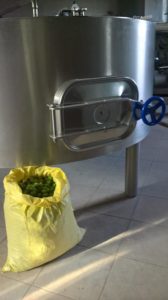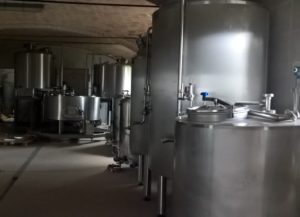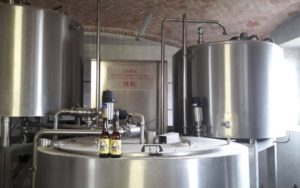 Inside the old walls of the farmhouse, which remained in disuse for almost fifty years, where in the past he draft oxen stayed, the peasant and artisan work has resumed today. This innovative project, unique in Italy and in Europe, makes it possible to transform cereal grains and hop cones gathered in the fields into beer. Ours is the only micro-brewery that aims to produce real birra contadina®, as essential and sincere as nature can create. The barley, after having rested at least three months after the harvest, is transformed into malt thanks to the small 6-quintal malting cycle with a process that lasts ten days. Malting is a delicate process, very susceptible to external conditions and the peculiarities of the caryopses. The control of the imbibition, germination, drying and roasting phases requires obsessive attention and technical knowledge and specialized skills. The results achieved so far in malting barley in several types of malt are the result of a process of experimentation and optimization of the machine carried out hand in hand with the growing of two-row barley. Getting a good malt means adding the quality of barley to the transformation process, with an intrinsic variability of each vintage, every field, every processing cycle. The peculiarity of Birra contadina® lies precisely in its variability: if this were not the case, it would evidently lack the naturalness, craftsmanship, the opposition to the industrialization of processes and techniques. The search for standardization in the brewing field, pursued also by many artisans, is to all intents and purposes a legacy of the massive industrial production that has shaped the mind and palate of consumers over time.
Inside the old walls of the farmhouse, which remained in disuse for almost fifty years, where in the past he draft oxen stayed, the peasant and artisan work has resumed today. This innovative project, unique in Italy and in Europe, makes it possible to transform cereal grains and hop cones gathered in the fields into beer. Ours is the only micro-brewery that aims to produce real birra contadina®, as essential and sincere as nature can create. The barley, after having rested at least three months after the harvest, is transformed into malt thanks to the small 6-quintal malting cycle with a process that lasts ten days. Malting is a delicate process, very susceptible to external conditions and the peculiarities of the caryopses. The control of the imbibition, germination, drying and roasting phases requires obsessive attention and technical knowledge and specialized skills. The results achieved so far in malting barley in several types of malt are the result of a process of experimentation and optimization of the machine carried out hand in hand with the growing of two-row barley. Getting a good malt means adding the quality of barley to the transformation process, with an intrinsic variability of each vintage, every field, every processing cycle. The peculiarity of Birra contadina® lies precisely in its variability: if this were not the case, it would evidently lack the naturalness, craftsmanship, the opposition to the industrialization of processes and techniques. The search for standardization in the brewing field, pursued also by many artisans, is to all intents and purposes a legacy of the massive industrial production that has shaped the mind and palate of consumers over time.

In the oldest part of the courtyard building, dating back to the 1700s, characterized by majestic brick vaults, are the installations of the cooking room. In the large 10 hectolitre mashing vat, thanks to the wise mixing of malts, to balanced heat, with the diluting effect of pure water, the wort takes shape. The liquid enhances the sense of smell and taste thanks to the wise dosage of hop cones, which release in the very hot vapours the vegetable essences that were already perceived in the field. These sensations recall the summer aromas, and the emphatic aromatic strength of the cones just removed from the living plant.
In the fermentation cellar, consisting of three open-air tanks and two isobaric tanks, the yeast works intensively. The selection of the strains is studied for the performance of the individual micro-organisms, but each crush uses the technique of co-inoculation with yeasts that were selected in 2016 directly in the field, on the ears of barley at milky maturity. Once optimized, this will allow us to draw from our own land also the microorganisms needed for conducting the entire fermentation.
 In short, we have a global commitment to bring nature and man back into balance. It is a challenge to globalization and the flattening of taste that are quietly suffocating us, reinforced by marketing policies that divert consumers’ view of food.
In short, we have a global commitment to bring nature and man back into balance. It is a challenge to globalization and the flattening of taste that are quietly suffocating us, reinforced by marketing policies that divert consumers’ view of food.
At the end of the process, the beer goes into the barrel or bottle, ready to be enjoyed. The best way to taste it? Sip it walking through the barley fields lulled by the spring breeze, or in the shade of the fresh hops on the hottest days.